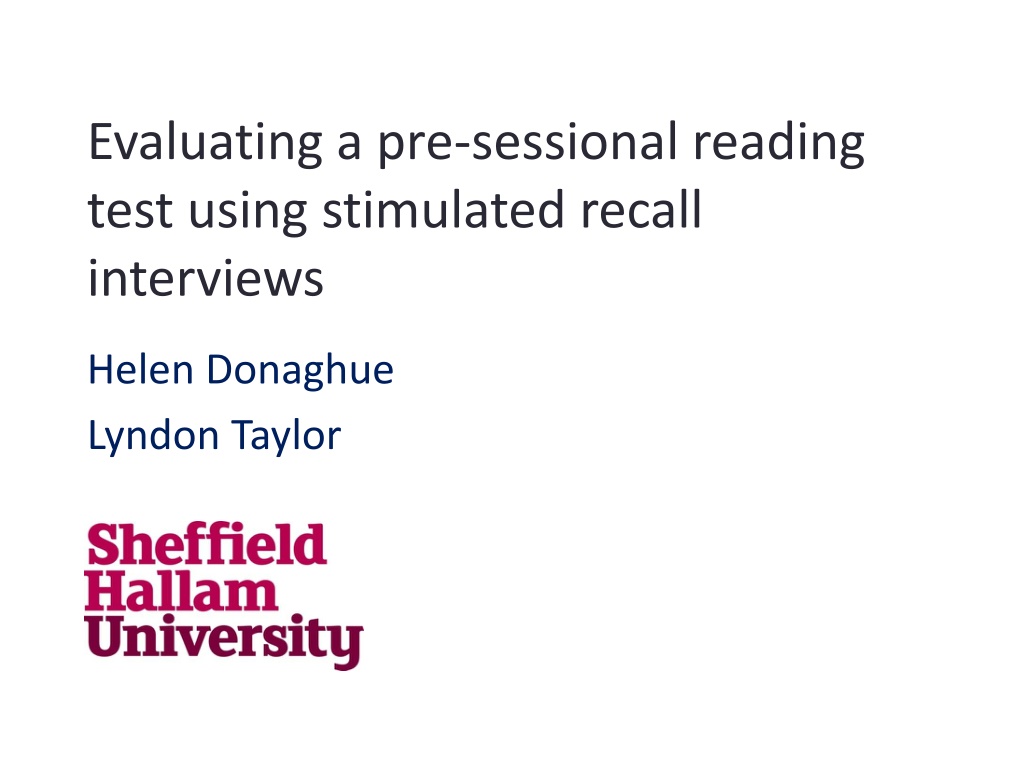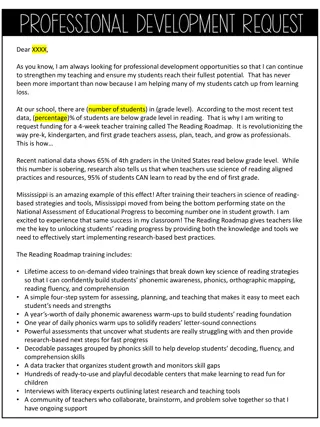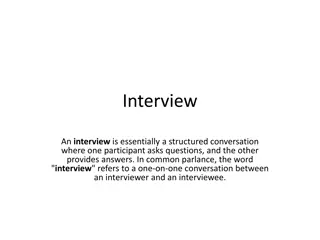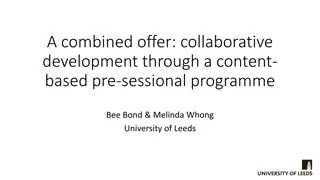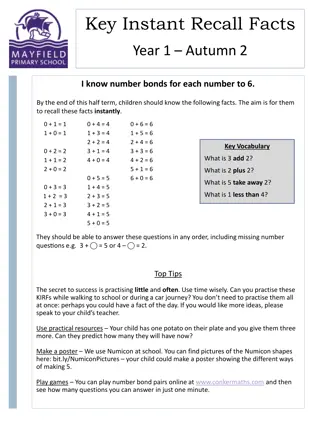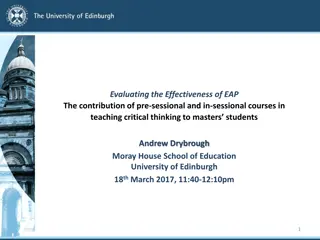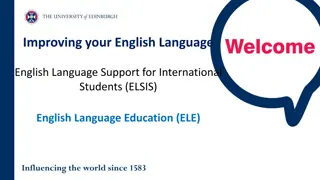Evaluation of Pre-sessional Reading Test Using Stimulated Recall Interviews
This evaluation study examines a pre-sessional reading test through stimulated recall interviews to understand how students tackled the test, what reading skills and strategies they employed, and if the test items effectively elicited the intended cognitive processes. Data was collected from two cohorts in May and December 2016, consisting of 49 test-takers who underwent interviews. The analysis involved question-by-question examination of cognitive processes and reading strategies. Results indicated insights into reading for main ideas using specific test items like Q40.
Download Presentation

Please find below an Image/Link to download the presentation.
The content on the website is provided AS IS for your information and personal use only. It may not be sold, licensed, or shared on other websites without obtaining consent from the author. Download presentation by click this link. If you encounter any issues during the download, it is possible that the publisher has removed the file from their server.
E N D
Presentation Transcript
Evaluating a pre-sessional reading test using stimulated recall interviews Helen Donaghue Lyndon Taylor Image result for shu logo
the test recall interviews 3 example test questions how this informed test revision teaching
test design long pre-sessional course reading test test plan
recall interviews How did students approach the test? What reading skills/strategies did they use? Did test items elicit the cognitive processes they were designed to elicit? Selected questions, covering all LOs.
data collection 2 cohorts: May & December 2016 49 test-takers in total, 23 interviews 2 researchers 20-30 minutes, as soon as possible after the test audio recorded, transcribed
analysis Statistics Transcriptions analysed question by question looking at cognitive processes and reading/test strategies Cross reference stats and interviews
results reading for main ideas
3 test items Q40, 24, 10
Q40 item facility: 0.41 point biserial: 0.52 Choose the correct letter, A, B, C or D. 40. The main message of the text is: A. New technology may cause loneliness. B. We should pay more attention to our health. C. Social contact is important for us. D. Women are more sociable than men. Can read carefully to establish purpose or main idea of the text by identifying or recognising main points that are central to the meaning
Shafiq: 88% - correct answer given: C 40. The main message of the text is: A. New technology may cause loneliness. B. We should pay more attention to our health. C. Social contact is important for us. D. Women are more sociable than men. Question 40 is the main idea, the whole text. One paragraph talks about A. 'Women are more social than men', only D paragraph talks about that. 'Social contact is important for us': this is the main general idea that is used in every paragraph.
Sultan: 28% - incorrect answer given: B 40. The main message of the text is: A. New technology may cause loneliness. B. We should pay more attention to our health. C. Social contact is important for us. D. Women are more sociable than men. I think we should do attention to our health. And they said like cigarettes, a lot of fatty food, they cause the problem. I chose from mind because I read it before and I chose B.
Q24: Correct heading: People are more aware of physical than social problems Evidence about the benefits of face-to-face social contact makes it difficult to understand why little attention has been paid to the importance of building social networks. One reason is that the media focuses obsessively on food, money, exercise and drugs. We recognise that cigarettes, salt, fatty food and being overweight can shorten our lives, while antibiotics, physical activity and a balanced diet can prolong them. This knowledge has changed the way most of us eat, work and spend our leisure time. But despite studies that confirm the benefits of social relationships, the number of people who say they feel isolated has almost trebled since the late 1980s, according to population surveys in Europe, the US and Australia.
Q24 item facility: 0.35 point biserial: 0.51 Can read carefully to establish the main idea of paragraphs by understanding discourse markers, cohesion and organisation, and distinguishing main idea from supporting details.
correct answer Shafiq: 88% - Option chosen: People are more aware of physical than social problems * What do you think the questions are asking you to do? What is the main general idea of the paragraph... So when I start doing it I read the paragraph, I have a general idea in mind, then I read all these headings.
correct answer Safa: 75% - Option chosen: People are more aware of physical than social problems First I read all the text carefully. I put a heading in my mind so when I moved to the question I already choose the nearest meaning in my mind. *So you had information in your mind for each paragraph and also the Arabic writing in the margin that --? Yes, that's summarising the paragraph. *So when you did the paragraph matching exercise did you need to go back to the text? Sometimes, for example, to ensure I've understood the question carefully.
Incorrect answer Musa: 40% - Option chosen: The effects of social relationships on health Evidence about the benefits of face-to-face social contact make it difficult to understand why little attention has been paid to the importance of building social networks. One reason is that the media focuses obsessively on food, money, exercise and drugs. We recognise that cigarettes, salt, fatty food and being overweight can shorten our lives, while antibiotics, physical activity and a balanced diet can prolong them. This knowledge has changed the way most of us eat, work and spend our leisure time. But despite studies that confirm the benefits of social relationships, the number of people who say they feel isolated has almost trebled since the late 1980s, according to population surveys in Europe, the US and Australia. I think about the first sentences and I move to the end. 'Confirmed benefit of social relationships, the number of people' and I found the answer. I don't know if it's correct or not.
Qs 10: Can read carefully to establish main idea of paragraphs by understanding discourse markers, cohesion and organisation, and distinguishing main idea from supporting details.
Question 10 Which of the following three main ideas are included in this text. Choose three options from the following list. You can write the answers in any order. A. the contagious nature of laughter (66% of students) B. the jokes people laugh at (13%) C. the reasons people laugh (92%) D. the negative aspects of laughter (32%) E. the laughter in shopping malls (29%) F. the development of laughter in children (63%)
distractor: The contagious nature of laughter Kareem (38%) *I see, okay, so you were choosing between A and F. Because maybe this I didn't understand the meaning of this. *So you chose it. Yes. Bai (55%) Because I don t know this word the meaning, I think maybe teacher want to examine and I just choose it.
distractor: The contagious nature of laughter Jing (80%) Actually I found this whole paragraph contagious is so I this question. *Yeah, so you ve got laughter is contagious at the end and you can t control it at the beginning. Yeah. *Do you know the meaning of contagious? Actually I don t know. *Okay, so why did you choose it if you didn t know the meaning? I guess this is maybe something you can t the whole meaning- *The whole thing, I see. and the nature means it s about you can t change it, it s from inside, yeah.
Questions 10 - 12 Which of the following three main ideas are included in this text. Choose three options from the following list. You can write the answers in any order. A. the contagious nature of laughter (66% of students) B. the jokes people laugh at (13%) C. the reasons people laugh (92%) D. the negative aspects of laughter (32%) E. the laughter in shopping malls (29%) F. the development of laughter in children (63%)
distractor: the laughter in shopping malls Min (63%) *And 'Laughter in shopping malls' why did you not choose that? Also because it was just a short idea here. Mai (55%) But laughter in shopping malls, I think for me, I don't know, it's not very important, I don't know, so that's why I didn't choose it. *Why do you think it's not important? Because it's an example, it's an example.
distractor: the laughter in shopping malls Kareem (38%) *Shopping Malls. Okay, do you think that's a main idea? But they're mentioned. *They're mentioned but the question is asking you about main ideas. Maybe a misunderstanding.
teaching practice: time Less time on scanning/reading for specific information, more on reading for main ideas Spending more time with the text as a whole before giving out any questions
teaching practice: awareness matching words doesn t work not every paragraph has a first topic sentence so the main idea of a paragraph is not always discernible from the first sentence
teaching practice: activities students read paragraphs and decide on their own heading before giving them headings to choose from students highlight texts/build diagrams to show main and supporting ideas pairs of strong/weak students do mini recall interviews together
reference Khalifa & Weir. (2009) Examining Reading. Cambridge: Cambridge University Press
